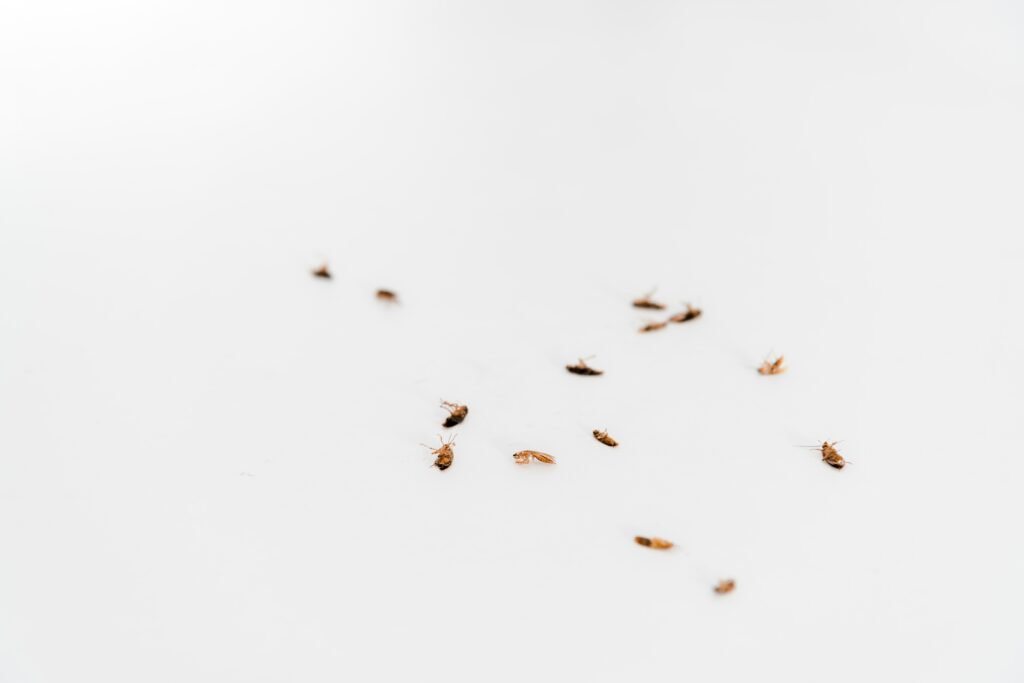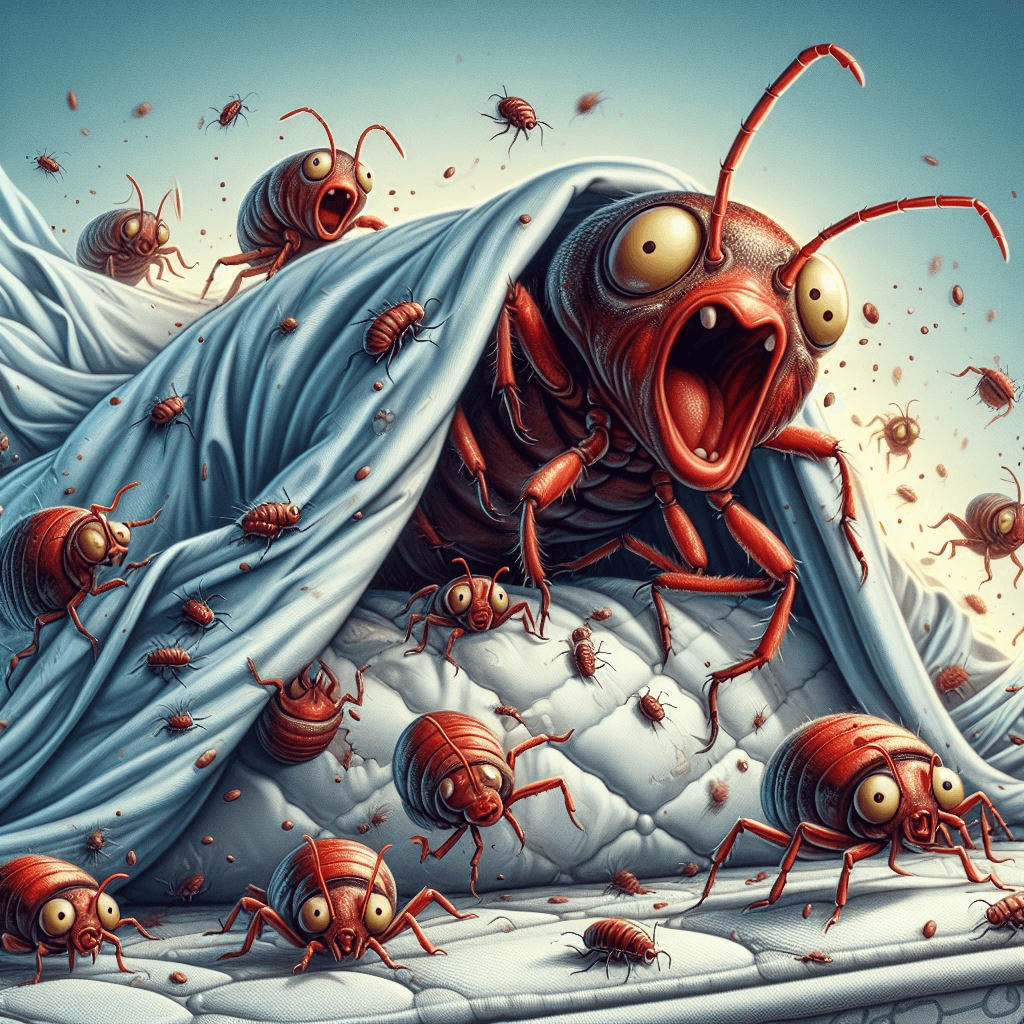In today’s bustling world, where health and mental hygiene take precedence, it is essential to ensure our safe havens remain free from the relentless invaders known as bed bugs. These tiny pests may seem insignificant at first glance, but they can wreak havoc on our comfort and well-being if left unchecked. Identifying bed bugs in our bedding is of utmost importance to prevent a full-blown infestation that can be both physically and mentally exhausting.
Be a Bed Bug Detective: Become a pro at detecting bed bug infestations with our comprehensive guide. Check out unmasking the elusive for expert tips and techniques.
The Importance of Identifying Bed Bugs in Bedding

There are several compelling reasons why identifying a bed bug problem and finding bed bugs in your bedding should be at the top of your priority list. Firstly, bed bugs are notorious for their fast reproduction rate, meaning what starts as a minor issue can quickly escalate into a major problem. By detecting them early on, you have a better chance of eradicating them before they multiply and spread throughout your entire home.
Furthermore, the biting habits of these resilient creatures can cause irritating allergic reactions or skin infections. For those with pre-existing respiratory conditions or weakened immune systems, the presence of bed bugs can exacerbate symptoms and significantly impact overall health.
An Overview of Signs and Symptoms
Now that we understand the importance of identifying both bed bug bites and bugs in bedding let’s delve into the signs and symptoms that may indicate their unwelcome presence. It’s crucial to note that while bites are often associated with bed bugs, not everyone reacts to them in the same way. Some individuals may exhibit immediate allergic responses to bed bug bites characterized by red welts or itchy bumps on exposed skin areas such as arms or legs.
Aside from physical reactions, there are other telltale signs to watch out for when inspecting your bedding. One common indicator is discovering dark brown stains resembling ink spots on your sheets or pillowcases.
These stains result from crushed live bed bugs, or their excrement, which is often digested blood. Additionally, you may come across tiny bed bug eggs, which are pearly white and about the size of a pinhead, hidden within the folds of your mattress seams or other furniture.
By staying vigilant and familiarizing yourself with these early signs of bed bugs in your bedding, you can take swift action to prevent a full-blown infestation. So let’s roll up our sleeves and learn more about how to conduct a thorough inspection in the sections that follow.
Understanding Bed Bugs
A Brief History: From Ancient Pests to Modern Intruders
Bed bugs, those pesky creatures that send shivers down our spines, have been tormenting humans for thousands of years. These blood-sucking insects have plagued civilizations across continents, from ancient Egypt to medieval Europe.
Although they were nearly eradicated in the mid-20th century, bed bugs have made a defiant comeback in recent decades. The resurgence can be attributed to increased international travel, changes in pest control practices, and the development of pesticide resistance among these resilient critters.
Characteristics of Bed Bugs: Hitchhikers with a Taste for Blood
So what exactly are these notorious pests? Bed bugs (Cimex lectularius) are small wingless insects with reddish-brown bodies that measure about 4-5 millimeters in length.
They possess flattened bodies that enable them to hide in narrow cracks and crevices around your home. Despite their name, they don’t just infest beds; they can also be found hiding in furniture, box springs, carpets, and even electrical outlets.
Life Cycle and Behavior: The Sneaky Night-time Feeders
Understanding the life cycle and behavior patterns of bed bugs is crucial when it comes to spotting them in your bedding. Female bed bugs lay tiny white eggs (about the size of a pinhead) which are often found in small clusters or clustered together.
These eggs hatch into something called nymphs, that resemble smaller versions of adult bed bugs but lack fully developed wings. Nymphs go through several molting stages before reaching adulthood.
Bed bugs are nocturnal creatures that prefer to feed on the blood of sleeping humans or animals. Their bites can cause itching and discomfort for some individuals while others may not react to live bed bugs at all.
After feeding—which typically lasts for long periods of about 5-10 minutes—they retreat to their hiding places. These cunning insects can survive for months without feeding, making their detection even more challenging.
Remember, knowledge is power when it comes to dealing with bed bugs. Understanding common bed bug and their history, characteristics, and behavior will help you in the battle against these unwanted intruders.
In the next section, we will dive into the physical inspection techniques that can help you with how spot bed bugs in your bedding and surrounding areas. Stay tuned!
Physical Inspection Techniques
Step-by-step guide to inspecting bedding for bed bugs
When it comes to detecting bed bugs in your bedding, a thorough physical inspection is essential. Start by stripping off all the sheets, pillowcases, and covers from your bed.
This allows you to have a clear view of the mattress and its surroundings, making it easier to spot any signs of an infestation. Remember, bed bugs are skilled at hiding in even the tiniest cracks and crevices.
Examining mattress seams, tufts, and edges for dark spots or stains

With the bedding removed, it’s time to focus on the mattress itself. Begin by closely inspecting the seams, paying particular attention to any dark spots or stains that may be present.
Bed bug excrement often appears as small black dots or smears on fabric surfaces. These dark stains can sometimes be mistaken for mold or dirt but are telltale signs of a bed bug infestation.
Move on to examining the tufts and edges of the mattress next. Bed bugs tend to hide in these areas because they provide ideal hiding place places for them during their feeding periods.
Look out for tiny reddish-brown insects with oval-shaped bodies about this size: apple seed. These are adult bed bugs that may be crawling around or resting in these crevices.
Inspecting box springs, headboards, and footboards for signs of infestation
After inspecting your mattress thoroughly, don’t forget about other potential hiding spots nearby. Check your box spring carefully using both your eyes and touch; run your fingers along its surface as you look out for any signs of bed bug activity such as shed skins or eggs stuck within crevices. Also examine your headboard and footboard during this process; remove them if possible or check around their edges and joints.
Bed bugs are known to infest these areas as well, especially if they have cracks or gaps that provide convenient hiding places. Keep in mind that even inside electrical outlets near the bed can be potential hiding spots, so it’s crucial not to overlook any potential areas of infestation.
Remember, thoroughness is key when conducting a physical inspection for any signs of bed bugs being in your bedding. Take your time to ensure you cover every crack, crevice, and fold in the bedding.
By following this step-by-step guide, you’ll increase your chances of identifying an infestation early on and taking prompt action to preserve both your health and mental hygiene. (Note: Information sourced from The Resurgence of Bed Bugs: A Historical Perspective)
Visual Clues to Look For
Identifying Fecal Stains on Bedding: A Telltale Sign of Bed Bug Activity

Paying attention to the appearance of your bedding can reveal vital clues about the presence of bed bugs. One of the most significant indicators is the presence of fecal or blood stains. These stains, which resemble tiny black dots, are often left behind by bed bugs as they digest their blood meals.
You may find these marks scattered across your sheets, pillowcases, or mattress. To confirm whether these marks indeed indicate a bed bug infestation, perform a simple test.
Dab a moist cloth on the stains and gently rub them. If they smear and create a reddish-brown streak, you have likely encountered bed bug fecal matter.
However, keep in mind that other pests like carpet beetles can also leave similar excrement behind. Therefore, it’s crucial to combine this observation with other signs mentioned in this article for a more accurate conclusion.
A Quick Tip:
If you spot suspicious black spots on your bedding but are uncertain about their origin or consistency, consider contacting professional pest control experts who possess specialized knowledge and tools to accurately identify bed bug infestations.
Recognizing Shed Exoskeletons: A Reminder of Molting Bed Bugs

In their journey from nymphs to adults, bed bugs undergo several molting stages where they shed their exoskeletons or outer shells in order to grow. These discarded skins serve as another visual clue indicating an active infestation within your bedding.
Shed skins can be found under bed sheets or near areas where bed bugs commonly hide during the day, such as small spaces such as mattress seams or cracks and crevices around your bed frame. These translucent shells are about the same size as an adult bed bug, measuring around 1mm in length.
They have a distinct amber color and a papery texture. Be thorough in your search, as you may find these shed skins not only on your mattress but also on upholstered furniture, bed frames, or even in loose wallpaper.
A Fascinating Fact:
Bed bugs molt five times before reaching adulthood, discarding their shed skins each time. By keeping track of the number of exuviae (shed skins) you find, you can estimate the level of infestation and make informed decisions about treatment options.
Noticing Bloodstains: Evidence of Feeding Bed Bugs
An unfortunate consequence of sharing your bed with unwelcome guests is the possibility of waking up to discover small bloodstains on your sheets. These stains occur when feeding bed bugs are accidentally crushed or when they withdraw after completing their blood meal.
The bloodstains left by bed bugs are often reddish-brown in color and may vary in size depending on how much engorgement occurred during feeding. They can be found anywhere on your bedding, from pillowcases to duvet covers, and even underneath your mattress if the infestation is severe.
A Thought to Ponder:
The idea of tiny creatures feasting on our blood while we sleep can be unsettling. But remember, identifying these bloodstains serves as a crucial step towards eradicating these pests from your home and ensuring restful nights free from unwanted visitors.
Unusual Hiding Spots
Exploring Less Obvious Areas Where Bed Bugs Can Hide in Bedding
When it comes to bed bugs, they are masters of hiding in unexpected places. While most people immediately check the mattress and box spring for these pesky pests, there are some lesser-known areas you should pay attention to find bed bugs as well.
For instance, have you ever thought about checking inside pillowcases or underneath pillows themselves? These cozy spots provide the ideal refuge for bed bugs due to their proximity to human hosts and the warmth they seek.
Additionally, be sure to inspect the seams or zippers of your duvet covers and mattress protectors. Bed bugs can easily squeeze into these crevices, making them perfect hiding places.
Inside Pillowcases or Underneath Pillows Themselves
The idea of bed bugs lurking inside your pillowcase may sound unsettling, but it’s a possibility you shouldn’t ignore. Lift your pillows and examine both sides thoroughly.
Look for any signs of small apple seed-like creatures scurrying around or dark brown stains that could be bed bug excrement. It’s also wise to give your pillowcases a shake outside while wearing gloves; this helps dislodge any hidden pests or bed bug eggs that may have taken refuge within.
Within Seams or Zippers of Duvet Covers or Mattress Protectors
Bed bugs are experts at squeezing into tight spaces, and seams and zippers are no exception. Take a close look at these areas on your duvet covers and mattress protectors. Using a flashlight, carefully inspect along the seams by running your fingers over them to feel for any irregularities such as blood spots or as small bumps (indicating potential bed bug presence).
Give special attention to corners where they may hide deeper within the folds. If possible, remove the coverings completely and put them in a plastic bag for further inspection or treatment if needed.
Using Tools to Aid Detection
Utilizing a Flashlight to Search for Hidden Bed Bug Harborage Areas
A flashlight can be your trusty ally in the battle against bed bugs. By illuminating the darkest corners, cracks, and crevices, it helps reveal their hidden hiding places. When inspecting your bedding, shine the flashlight along seams, around tufts, and even under the bed frame or behind furniture near your sleeping area.
Be diligent in checking inside electrical outlets as well; although rare, bed bugs have been known to hide there too. Remember to seal cracks and seal them properly using appropriate materials recommended by experts or pest control professionals.
Employing a Magnifying Glass to Spot Tiny Eggs or Nymphs

Sometimes, detecting bed bugs can be quite challenging due to their small size. This is where a magnifying glass becomes invaluable. Use it to examine fabrics and mattresses closely for any signs of eggs or nymphs – offspring of adult bed bugs – which are often difficult to spot with the naked human eye, alone.
These tiny creatures are pale and translucent when young but gradually darken as they feed on blood. Take your time while inspecting; even carpet beetles can be mistaken for bed bug nymphs due to their similar appearance but less harmful nature.
Detecting Bed Bug Odor
Describing the Distinct Musty Odor Emitted by Large Infestations
Bed bugs not only leave physical traces but also emit an unmistakable odor that intensifies with larger infestations. Described as musty or sweet, this distinct smell arises from glands on their bodies that release pheromones.
If you notice this particular scent lingering around your bedding area, it’s essential not to ignore it. Remember that human noses may differ in their ability to detect this smell, so it’s crucial to pay attention to other signs as well.
Explaining How Human Noses May Differ in Detecting This Smell
Each person has a unique sense of smell, which means some individuals may be more sensitive to the odor emitted by bed bugs than others. Factors such as allergies, sinus conditions, or even a naturally heightened olfactory perception can influence one’s ability to detect the distinct scent. Additionally, prolonged exposure or familiarity with the odor might cause desensitization over time.
Therefore, relying solely on your sense of smell may not be foolproof. Combining it with visual inspections and other signs mentioned earlier will provide a more accurate assessment.
Conclusion
In your quest to spot bed bugs in your bedding, it’s crucial to be thorough and meticulous. Explore the usual hiding spots like inside pillowcases and seams but also pay attention to the less obvious areas such as underneath pillows or within zippers. Utilizing tools like flashlights and magnifying glasses can greatly aid detection, allowing you to spot tiny eggs or nymphs that might otherwise go unnoticed.
Don’t underestimate the power of your sense of smell; it can assist in identifying large infestations through the distinct musty odor emitted by bed bugs. Remember, early detection is key when dealing with bed bugs.
By spotting them early on, you can take prompt action and seek professional assistance if necessary—keeping your home free from these unwanted visitors and ensuring restful nights for you and your loved ones. For further information on how to check for bed bugs in your home or professional assistance, please visit our article The Resurgence of Bed Bugs: A Historical Perspective.
Overcome bed bugs with D-Termination: The top-notch pest control service in Las Vegas!

Are you experiencing trouble with bed bugs in Las Vegas? Look no further than D-Termination for assistance. Our team of skilled professionals excels in eradicating bed bug infestations and restoring comfort to your living area. Bid farewell to bed bugs by opting for D-Termination’s effective pest control solutions today!
To schedule your bed bug control service and reclaim your space from these relentless pests, feel free to contact us at 702-919-6310 or visit dtermination.com.
Frequently Asked Questions:
You can check if bed bugs are on your clothes by visually inspecting them for any signs of bed bugs or their droppings. You can also use sticky tape or a lint roller to catch any bed bugs or their eggs.
Yes, bed bugs are visible to the naked eye. They are small, but still visible, and have a reddish-brown color.
If you suspect you have bed bugs, it’s important to gather evidence such as bites, physical signs, or actual bugs. If you’re unsure, consider seeking a professional opinion to determine the presence of bed bugs.
The duration of a bed bug infestation without awareness can vary. It depends on factors such as the size of the infestation and individual sensitivity to bites. It could take weeks or even months before you realize you have bed bugs.
If you found this article to be enjoyable, you might also find the following related content of interest:
Unveiling the Stealthy Pests: A Comprehensive Guide to Unearthing Bed Bugs Lurking in Your Furniture








